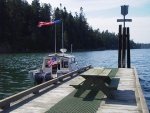You can do it!
This lady did the whole loop solo in a Ranger 25. She had some solo locking adventures; I thought it was a good read (and you can likely afford it at $7.99).
https://www.amazon.com/dp/B01M63E3F3/re ... TF8&btkr=1
Lots of loopers on jet skis have locked solo on just one cable (or pipe, or worst of all, dangling ropes with a weight on the bottom that are NOT secured to the bottom of the lock). When cables were 12 ft or so apart, we liked a line around the first and third, which gives the best control, esp if you’ve installed a cockpit midship cleat to hold a line while going to and from the helm. This is an exception to the general rule that you don’t want a bow line long enough to foul your props. Keep a potline cutter and a HH VHF in the cockpit full time. The plastic coated cables and pipes stay outside your boat, but the dangling lines are slimy and muddy and again I would like a midship cleat to loop it around if it’s just me holding in a 10,000 lb boat in windy/tough conditions. Have fenders on both sides as the lockmaster may direct you to either side. Unwritten protocol is the first boat chooses which side she wants and those behind alternate populating each wall. A few locks allow a boat on only one side due to way it’s filled.

Position the boat so your fenders won’t get caught in a recessed ladder like this or a missing wall chunk.

The NYcanals site has info on each lock, cable/pipe/rope, etc:
https://www.canals.ny.gov/wwwapps/boating/locks.aspx
You don’t want ‘giant’ fenders that are so big they keep you so far from the lock wall that you have to lean way over to grab a cable/pipe/line. Keep a high quality boat hook in the cockpit with your HH VHF (on 13), gloves and potline cutter.
You’ll prefer a starboard wall with a starboard helm where you look right down on your rubrail and upcoming cables. Approach with a lot of neutral gear with only the port engine occasionally in gear (the stbd prop is too close to the wall, esp in reverse when backing towards the wall).
Our worst locking experience of 166 locks to date was the Joe Wheeler lock on the Cumberland/Tennessee adventure. The inflow backwash was so great that I couldn’t hold the bow line to the wall and Eileen couldn’t keep the aft boat off the wall with her boathook, so the engine cowling scraped up against the rough concrete for 40 feet. A Yamaha F150 cowling is 2 Boat Units, so it was not a good boating day. Credit to Dr Bob (as so often) for the midship cleat suggestion to help hold 10,000 lbs of boat in place by a couple of under 145lb 65 year old weaklings. Sorry to be so insistent on the need for a midship cleat (esp Shafer SS 8”, only 2 bolts each , a 20 minute, one beer job for both sides).
I’m not convinced a bow line around a single midship or so cable then cleated to the aft cleat would secure a TC255 sufficiently and safely 95% of the time (esp with a single slimy weighted rope held only by you on a 10,000 lb boat against the wind on a windy day without a cleat). Your boat could end up in the middle of the lock with you holding the lock line bottom weight in your hands until it pulls you overboard or the boat slams into a boat on the other side of the lock. At least you had fenders on both sides!
So, I have a midship cleat fetish after our experience. That doesn’t mean you have to have one too.
Yep, you can do it! Don’t get upset when you get some cosmetic scrapes and dings, we get a lot and if we weren’t a team I alone would get a lot a lot more as there are blind spots etc to deal with.
The vast majority of the time it's as flat calm placid fun as these pics where a blind man could do it by ear!
Hope this helps; PM or call with any issues!

John





